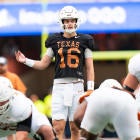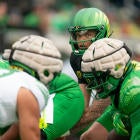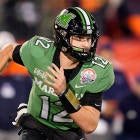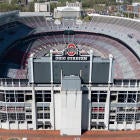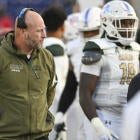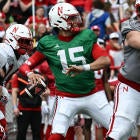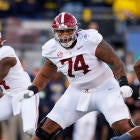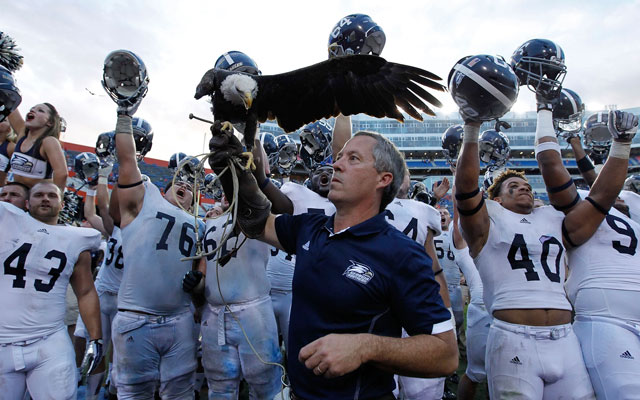
Inside College Sports is a weekly notebook looking at issues occurring off the field in college sports — big business, court cases, NCAA governance, health and safety, etc. Have a tip, idea or question about a certain topic? Email me at jon.solomon@cbsinteractive.com.
Comments by a Sun Belt Conference commissioner at the league's media day usually won't generate much attention. But Karl Benson’s remarks this week warrant further consideration.
Benson said he wants Sun Belt teams to try to shed their “addiction” to lucrative, nonconference games against heavily favored Power Five opponents. He wants to improve the Sun Belt’s chances of having an undefeated team to reach a College Football Playoff access bowl and increase the league’s portion of CFP money divided among Group of Five schools.
“This isn’t anything new I’m saying, but it’s the first time we’ve had all 11 schools around the table that had been with the Sun Belt for a period of time for stability,” Benson told CBSSports.com. “Rather than playing multiple million-dollar payday games, we’re better off to get a return on our investment, so to speak, on the back end by being able to win games against our peer opponents.”
Often unnoticed by the public in the playoff era is how the Group of Five conferences -- Sun Belt, Conference USA, MAC, Mountain West and American Athletic Conference -- are using the old BCS computer rankings to help divide their playoff money. Group of Five leagues receive about $75 million to divide between them -- $60 million is split evenly and the other $15 million gets disbursed based on the old BCS computers.
The Mountain West, which got an extra $6 million for Boise State going to a College Football Playoff bowl, received the most money at $23.5 million. The payouts to other leagues: $16.3 million to C-USA, $15.2 million to the American, $14.1 million to the MAC, and $12 million to the Sun Belt.
“If Arkansas State beats Toledo in the GoDaddy Bowl, we’re probably at No. 4,” Benson said. “That’s a $2 million swing.”
Benson’s idea is easier said than done. Money games are a likely loss on the field but guaranteed money to help balance athletic department budgets. This year, the Sun Belt’s 11 teams combined play 19 of their 35 nonconference games against teams from the SEC, Big Ten, Pac-12, ACC and Big 12.
Example: Arkansas State opens 2015 against USC and Missouri and Louisiana-Monroe plays Georgia and Alabama in the first three weeks. On the flip side, Louisiana-Lafayette has followed Benson’s model by playing Ole Miss, Boise State, Louisiana Tech and an FCS opponent in 2014, and Kentucky, Akron, Louisiana Tech and an FCS team in 2015.
If Sun Belt teams changes their model, it could have future repercussions on the SEC, which plays nine games against the Sun Belt in 2015. As the divide between haves and have-nots grows in college sports, it’s possible one day Power Five teams will decide to play only themselves anyway.
“We have seen schools that have weaned themselves off these money games,” Benson said. “I hate to always use Boise State as an example, but Boise State had a scheduling model and they had a plan. Does it require university support? Absolutely, it does.”
ADs have questions as O'Bannon injunction looms |
|
By now, a decision in the Ed O’Bannon appeal was expected to have come from the US 9th Circuit Court of Appeals on whether Judge Claudia Wilken correctly ruled that football and men’s basketball players could be paid deferred licensing money and the full cost of attendance. Since it’s unclear when a decision will come, the NCAA wants to stay the injunction, which would go into effect on Aug. 1. That’s the day schools can make offers of future payments to football and men’s basketball players, who could start to receive that money in 2016-17. Some schools are ready, others are not. A year after Wilken's ruling, several athletic directors in Power Five conferences conveyed to me questions they still have about what the decision means if it holds. * How does O’Bannon, which only addresses football and men’s basketball players, affect Title IX? If female athletes don’t get paid, are universities setting themselves up for Title IX litigation? Some ADs are prepared to provide men and women with an equal amount due to public backlash and legal concerns. * Are walk-on players required to receive cost of attendance and/or deferred licensing money? Wilken used the term “recruit” -- for instance, no school can offer a recruit more licensing money than any other recruit in the same class on the same team -- but the word “recruit” could mean walk-ons based on NCAA definitions. * Is the deferred money taxable income? It’s possible athletes would have to pay taxes for each year they’re credited with the new money, even though based on Wilken’s injunction they wouldn’t pocket the cash until they have stopped playing college sports. * Where is the deferred money -- perhaps $5,000 per year -- housed until a player’s eligibility expires? Do schools create a trust fund? Do they store the money in their private athletic foundations? Is that permissible under varying state laws? * Do schools write the deferred money offers into financial aid agreements starting Aug. 1? What if a school offers $5,000 a year to a recruit who accepts the deal and O’Bannon later gets overturned? Does the player still get the $5,000 even if the money conflicts with NCAA rules? “There are so many unanswered questions,” one AD said. “I have no clue how to handle it.” |
Alabama's COA stipend among highest nationally |
|
The cost of attendance stipends that Crimson Tide players are set to receive will rank among the leaders nationally at $5,386 for out-of-state players and $4,172 for in-state players, according to information the university provided to CBSSports.com. This represents a 34-percent increase in Alabama's cost of attendance figure for out-of-state students from two years ago and a 14-percent increase for in-state students. |
Read 'em |
|
Each week this space will highlight some excellent recent work by college sports media on difficult topics to report. * Steve Berkowitz of USA Today Sports reports the NCAA will distribute $18.9 million in new money to Division I schools to help pay for cost of attendance, additional food available to athletes or various academic projects. Schools will get about $55,000 apiece. * Rich Exner of the Northeast Ohio Media Group writes that rising education costs pale in comparison to the increasing bill for college sports at most Ohio public universities. * John Canzano of The Oregonian uses a public record request to show how concerned Oregon athletic department officials are about men’s basketball ticket sales despite coming off a 26-10 season with an NCAA Tournament appearance. |
Quote of the week |
|
“So I’m telling our fans, expect those people that are our enemies to talk bad about us, we finally won enough games, although it wasn’t all that much last year. We finally won enough that they’re trying to convince us that my age has something to do with it and I can’t coach anymore.” -- South Carolina coach Steve Spurrier in a hastily called and bizarre news conference. Spurrier previously provided ammunition against South Carolina in recruiting by saying he might coach two to three more years and considered retiring after 2014. |
Follow and read more from Jon Solomon on Facebook and Twitter.












